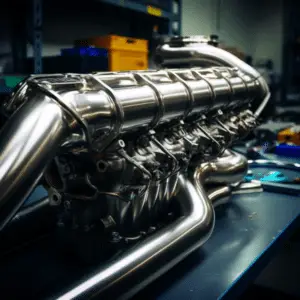
Performance Legalities and Emissions Compared
Are you in the downpipe aftermath and wondering whether to go with catted or catless? Then, you are on the right track. In this article, you will find a detailed comparison between catted and catless downpipes that might help you make an informed decision.
What is Downpipe?

Downpipes form part of the exhaust system of your car. It serves a very paramount role of connecting the catalytic converter and the header, thus channelling the exhaust gas to the converter before it exits the exhaust system. If you’ve not laid more emphasis on the performance of your car, then it’s unlikely that you’ve considered the downpipe responsible for the exhaust fumes moving through the catalytic converter.
For most people, as long as the vehicle moves well, they are mindless about the other car aspects. However, a downpipe forms the main conduit of the exhaust fumes from turbine housing. Notably, within the entire length of the downpipe, a restrictive catalytic converter is responsible for cleaning exhaust gasses. The clearance of the dangerous substances found in the exhaust fumes causes detrimental effects on the human respiratory system.
Downpipe discussion is an everyday topic for conversation among the vehicle’s enthusiasts who are too much into performance and ultimate performance of their machines. When you fit your car with a turbocharger, you should consider changing the downpipe to another alternative that boosts airflow, thus enhancing the vehicle’s performance. Unfortunately, many turbocharged cars have restricted performance because of the poor natural flow of exhaust fumes through the bending pipe. Switching out for the best downpipe can be a daunting task. Let’s compare catted and catless downpipes.
Downpipe Guide- Catted Vs Catless

People typically talk about catted and catless downpipes. However, what are the main differences between the two?
Catted downpipes have a high-flow catalytic converter that cleans the exhaust gases like the OEM catalytic converter. Unfortunately, the catless downpipe doesn’t have a catalytic converter. Therefore, the exhausts release unpleasant smells. That is the main reason you can smell nasty and respiratory attacking fumes sometimes on the roads. They are produced because the final product has not been cleaned as required. Fortunately, the car has excellent airflow; thus, its performance is undoubtedly improved.
Most vehicles have a standardized downpipe that has a restrictive catalytic converter. While the restriction is paramount in keeping the air clean and friendly to the environment, it affects vehicle performance negatively. It’s so disappointing to spend lots of dollars in improving the capacity of your vehicle then later discover that it’s working under restricted performance. The main downside of the standardized downpipe is the limited or restricted nature of the car’s performance.
catless downpipe
However, the catless downpipe improves airflow by eliminating restriction. Catless downpipes have larger diameters to allow exhaust gasses to flow and the turbo to spin. In basic terms, it lets users enjoy good automotive performance.
Catless downpipes eliminate back pressure and speed turbocharging. As you may expect, catless downpipes have other benefits. Further questions and worries remain. The first is smell. Catless downpipes lack reliable catalytic converters like catted downpipes. Thus, exhaust fumes contain several hazardous chemicals. It can harm anyone who smells it, especially elderly persons with poor immune. It partially causes other serious bodily system issues.
The second catless downpipe issue is legality. Authorities require catalytic converters for this reason. That is familiar to you, and you likely know your state’s laws. Climate change threatens all life on Earth, thus car owners should use catalytic converters to avoid harming them. The greenhouse effect of uncleaned exhaust gases causes global warming.
Catless downpipes increase vehicle CO2 production, unlike catted downpipes that remove carbon dioxide from exhaust fumes with catalytic converters. Fortunately, catless downpipes reduce other hazardous chemicals that can affect humans immediately. In some US states, a catless downpipe can result in a $2,750 punishment. Some situations involve car impoundment.
Overboost, or boost creep, is another catless downpipe issue. Overboost occurs when air builds up in the turbine housing with the turbocharger. Boost creep enhances capacity and sound, but it overloads the OEM fuel system. The end outcome is severe automobile damage.
Catted downpipes with catalytic converters offer the best of both worlds. First, it decreases power loss and improves car efficiency. Second, noxious-gas-free exhaust emissions make your car legal to drive on the street with a catted downpipe. If you’re seeking for the greatest downpipe for your vehicle, choose one with more performance without breaking the law.
Conclusion: Comparisons between Catted Downpipes and Catless Downpipes
Comparison | Catted Downpipe | Catless Downpipe |
| Catalytic Converter | Yes | No |
| Check Engine Light | Yes (lower chance) | Yes (definitely) |
| Daily Drivable | Yes | No |
| Emission | Tolerable | Not Tolerable |
| Emission Test | Pass (Visual & OBD2) Fail (Sniffer) | Fail |
| Needs Tuning | Recommended | Recommended |
| Performance | 40 HP | 50 HP |
| Price | Expensive (approximately $350) | Cheaper(approximately $150) |
| Smell | Slight oil smell | Significant oil smell |
| Sound | Good | Good but louder |
